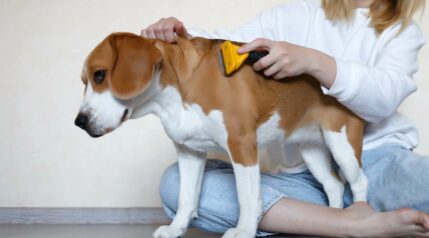Is chocolate your favorite sweet treat, and you’re wondering if Fido can share it with you? Or maybe you think just a little bit of chocolate won’t do your pooch any harm? Before you dish out any chocolatey treats, let us tell you that chocolate is toxic to dogs, and they should not have any at all. Although it is rarely fatal, although it can be, it can cause significant illness in dogs.
Many factors influence how much chocolate a dog can eat before they become ill, and it isn’t just down to how small or large your pooch is. Consuming just a little chocolate can harm some giant dog breeds. So, it’s best to avoid it altogether. Unfortunately, dogs eat anything they can get their paws on. So there are some things you can do to prevent them from eating chocolate.
But we doggy owners know all too well that accidents happen. So in this article, we look at why it is toxic to dogs, the symptoms of chocolate poisoning, and what to do if you suspect your pup has given in to chocolate temptation. It happens to the best of us! Plus, we explore all the other important chocolate information you need. So, let’s jump straight in.
At A Glance: Our Favorite Dog-Safe Chocolate Treats

Peanut Butter & Carob Cookies

"Chocolate" Dog Ice Cream

Carob Sandwich Cremes
Is Chocolate Toxic To Dogs?

Yes, chocolate is toxic to dogs, and depending on various factors, it can cause a medical emergency. Although it isn’t usually fatal, ingesting chocolate can result in significant illness. So dogs should not consume chocolate made for humans in any form. Eating a crumb of chocolate off the floor shouldn’t cause a huge problem, but you should do everything possible to keep chocolate away from them.
Chocolate contains small amounts of caffeine and a chemical called theobromine. The concentration of theobromine is up to 10 times that of caffeine, but they both contribute to chocolate poisoning. Canines cannot metabolize theobromine or caffeine as humans can, so they are sensitive to the chemical’s effects. These ingredients can also speed up their heart rate and stimulate a dog’s nervous system, leading to secondary health concerns.
How Much Chocolate Is Poisonous To A Dog?

How much chocolate is poisonous to a dog depends on various factors. The first factor depends on the type of chocolate they have consumed. Different chocolates contain different levels of theobromine. The general rule is the more bitter and darker the chocolate, the more toxic it is to dogs.
Here are a few types of chocolate listed in order of theobromine content (highest to lowest):
- Cocoa powder (800mg/oz)
- Unsweetened baker’s chocolate (450mg/oz)
- Cocoa bean hulls (255mg/oz)
- Dark and semisweet chocolate (150-160mg/oz)
- Milk chocolate (64mg/oz)
- White chocolate (0.25mg/oz)
As you can see, cocoa powder and unsweetened baker’s chocolate have a much higher concentration of theobromine than milk chocolate and white chocolate. Although white chocolate rarely poses any threat of chocolate toxicity to dogs, it’s still best to avoid it due to the high amounts of sugar and fat.
How much chocolate is poisonous to a dog also depends on the size of your dog. Mild symptoms of chocolate toxicity occur when a dog consumes around 20mg of theobromine per kilo of body weight. If your dog consumes 40 to 50mg/kg, it can trigger cardiac reactions, and doses higher than 60mg/kg can result in seizures. To put it into perspective, an average Hershey’s milk chocolate bar weighs 1.55 oz. So eating just one chocolate bar can have disastrous consequences, especially for a tiny pooch.
A Personal Experience When A Dog Ate Cocoa Powder

I went to Amsterdam for work a few years ago and came back with a coveted boc of Van Houten Dutch Cocoa for my family to enjoy in hot cocoas. But, before I could store it in the cupboard, my black Lab, Storm, sniffed it out in my bag and took the liberty of helping himself to the tasty treat. Cocoa powder is the most toxic to dogs of all chocolates and he was almost immediately vomiting it back up.
I called the vet and they said that since he did not eat very much before he started immediately vomiting he should be okay, especially if we can tell he gets it all out of his system. They also instructed us to keep a close eye on him for unusual behavior in the next 24 hours. Luckily, he threw up a few more times and then was completely himself again.
If his body had allowed time for the cocoa to digest and work into his system before rejecting it, we would’ve had a long night in the emergency vet. We were lucky but learned to NEVER ever leave chocolate anywhere a dog can possibly be tempted!
– Michelle S., Love Your Dog
What Are The Signs Of Chocolate Poisoning?
Symptoms of chocolate poisoning usually develop between 6 to 12 hours after consumption. Symptoms can show quicker in smaller or older dogs or those with heart conditions. And they are also more at risk of dying from chocolate toxicity. The symptoms can last up to 72 hours, and they include some of the following:
- Diarrhea
- Vomiting
- Increased urination
- Restlessness
- Abnormal or elevated heart rate
- Tremors
- Seizures
- Collapsing
What Should I Do If My Dog Eats Chocolate?
We have a separate guide on what to do if your dog has eaten chocolate. But if you suspect your pup has consumed chocolate, it’s best to call your vet immediately and ask for advice. Alternatively, you can call the Pet Poison Helpline. Provide information such as what kind and how much chocolate they have eaten, when they ate it, and the size of your dog. They can offer the best help and advice.
What Is The Treatment For Dog Poisoning?

The type of treatment required depends on various factors, including the amount and type of chocolate eaten. Many dogs can be decontaminated if you seek treatment early, including administering activated charcoal and inducing vomiting. Some dogs might benefit from repeated treatments of activated charcoal to reduce the reabsorption and recirculation of theobromine. Activated charcoal prevents the absorption of theobromine.
If your vet thinks they have ingested a toxic amount of chocolate and need more treatment than the above, they might keep them under observation. Your dog might also require intravenous fluids and medication to treat restlessness and other symptoms of toxicity.
Every dog is different, so it is best to seek advice from your vet immediately. Time is of the essence. All veterinary treatment can be costly, especially in emergencies. Chocolate toxicity treatment can range in cost from $250 to $3,000, depending on the severity. This is why it is essential to consider investing in pet insurance before your four-legged best friend gets into trouble.
How To Prevent Your Dog From Eating Chocolate
Dogs love exploring and eating, so they forever eat things they shouldn’t. And because chocolate is sweet and delicious, it’s hard to resist. The main step to prevent your dog from eating chocolate is to put it out of paw’s reach on a high shelf or closed-door pantry. It’s also important to tell your children and guests not to give your pooch any chocolate or leave it lying around.
When you are out of the house, your pup undoubtedly explores your home with their nose, seeking out naughty titbits. Crate training your pooch helps to keep them out of harm’s way when you are not there. If they are safely contained in a crate, they cannot get hold of that chocolate slab you forgot to put away. Accidents happen to the best of us.
Lastly, teaching your pooch the “leave it” command is extremely helpful in preventing dogs from eating something dangerous or toxic. You can be extremely careful at home, but you never know what Fido might find outdoors. It’s a simple command to teach and helps keep them safe.
Frequently Asked Questions
Do Dogs Like Chocolate?
Yes, absolutely. It’s sweet, creamy, and a little bit naughty. What’s not to love? And unfortunately, most dogs feel the same way too. Whether it’s in your hand or just lying around, there aren’t many dogs that can resist it. So, as the responsible parent, it’s down to you to prevent them from getting their paws on it. A dog-safe alternative to chocolate is carob, commonly used in dog treats and just as tasty to dogs. Check out these delicious carob peanut butter cookies or carob sandwich cremes that your pooch is bound to adore.
Can Dogs Eat Chocolate Cake?
No, dogs cannot eat chocolate cake. Dogs should not eat chocolate in any form, and chocolate used for baking usually has a higher concentration of theobromine. So whether the cake has chocolate sauce, chocolate chips, or is flavored with cocoa powder, it’s a huge no. Even scrumptious chocolate brownies are a no-go.
What Chocolate Can Dogs Eat?
The only chocolate that dogs can eat is “chocolate” that’s been specifically made for dogs. Whether it’s actual doggy chocolate or chocolate-flavored dog treats, such as this tasty “chocolate” carob dog ice cream, that’s okay. But your dog should avoid any food containing chocolate not explicitly made for dogs.
Final Thoughts
So now you know that chocolate can be highly toxic to dogs. In the best-case scenario, it might not make them ill or a little unwell with a poor tummy. But in the worst-case scenario, chocolate toxicity can lead to cardiac problems, seizures, and even death. With that in mind, and because every dog reacts differently, you should do everything possible to keep chocolate out of their reach. And with doggy-safe carob alternatives, there’s no need to give them any human chocolate.





